Medical center urges others to utilize secondary imaging reads after finding nearly 70% discrepancy rate
Radiologists at one tertiary care center spotted a high rate of discrepancies during their secondary interpretations, according to a new analysis. Experts suggest institutions begin dedicating resources toward such re-reads in order to catch potential errors.
The University of Vermont Medical Center receives many referrals, and its abdominal imaging division is often tasked with reinterpreting MRI exams from outside community hospitals. And after analyzing its practices, the center found nearly 70% of cases contained at least one discrepancy, with faulty reasoning the most common cause of error.
Disagreements between radiologists are typically higher for MRI exams and oncology cases, the authors noted, but pinpointing them is the first step to addressing the problem.
“Error rates in radiology are an important subject of many quality improvement projects because these errors can lead to delayed diagnosis and treatment of patients,” Danielle E. Kostrubiak, with the Burlington, Vermont, institution’s radiology department, and colleagues wrote Wednesday. “An important aspect of quality improvement is not only to identify the problem and its occurrence rate but also to determine why the problem occurred,” they added.
And with the help of Los Angeles County + USC Medical Center they did just that, and retrospectively looked at 357 secondary MRI reports completed between January 2015 and December 2018. Outside reports were compared to corresponding re-reads, noting any discrepancies.
Out of the entire caseload, 246 (68.9%) contained at least one discrepancy—defined as a change in the answer to the clinical question from the initial to final report. Most of these errors, the authors noted, were due to faulty reasoning (34.3%), which involves misidentifying an abnormality.
Their overall rate is higher than commonly reported in the literature, with one recent meta-analysis tallying 31%. Kostrubiak et al. suggested a few possibilities for their results, including their inclusion of only MRI scans and the high number of cases double-read for cancer staging.
While the team wasn’t able to study how these errors may have impacted patient care, they suggested doing so in a follow-up investigation.
“The data suggest that subspecialty interpretations should be encouraged at tertiary care centers, and institutions should provide adequate resources for these interpretations to occur,” Kostrubiak and colleagues added. “The next step would be to explore how these discrepancies may impact patient outcomes and overall cost to the system associated with these radiologic errors.”
Read the entire study published in the American Journal of Roentgenology here.

